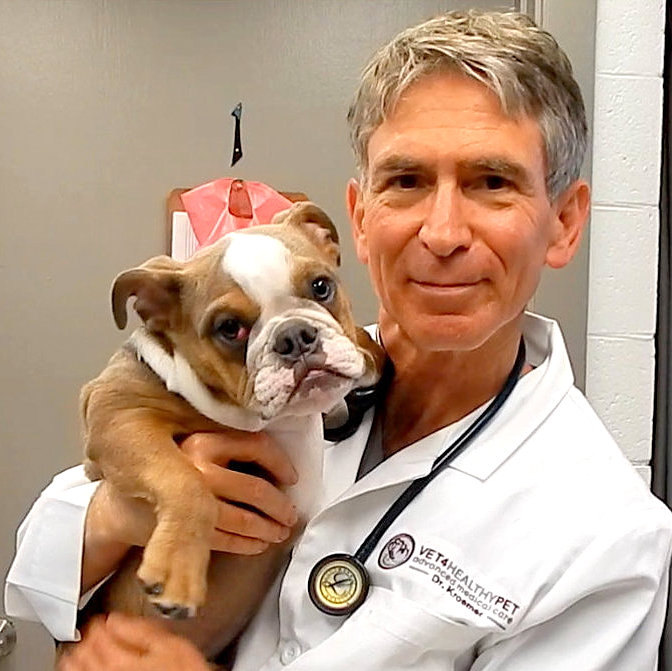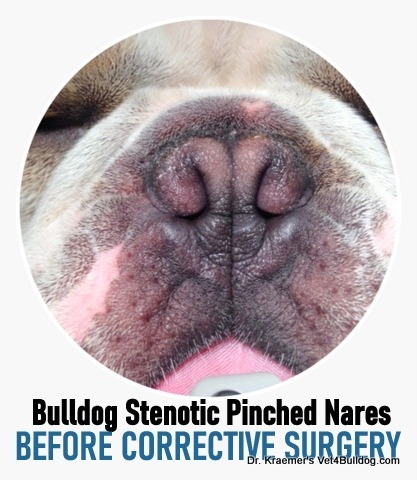Brachycephalic Airway Syndrome in Bulldogs and French Bulldogs (BOAS) is also known as “Brachycephalic Obstructive Airway Syndrome”
Your bulldog’s flat-headed, condensed facial structure has an undesirable effect on the anatomy of the neck and head and its relation to the respective soft tissues and other structures.
“Brachycephalic” is Latin for “flat head”.
Bulldog Brachycephalic Obstructive Airway 5 X MUST KNOW
- Stenotic Nares and elongated soft palate are the two most common BOAS
- BOAS is a debilitating, life-threatening respiratory condition that compounds with each other and gets worse over time.
- BOAS usually presents with loud breathing that gets worse during excitement and activity.
- Management includes weight control, a stress-free environment, a cool temperature, supplements, and surgery
- Prevention & Care includes Dr. Kraemer’s Affordable BOAS Bundles
Members of this bulldog community prefer prevention over RX
Brachycephalic Airway Syndrome in Bulldogs /ANATOMICAL ABNORMALITIES:
Bulldog BOAS refers to a set of primary and secondary upper airway anatomical abnormalities.
The primary and secondary abnormalities are caused by:
- AIRWAYS NARROWING: the narrowing of your bulldog’s upper airways
- AIRWAY COMPRESSION: compression of your bulldog’s upper airways
- AIRWAY RESISTANCE: increased airway resistance
- NEGATIVE PRESSURE: increased negative intra-airway pressure (i.e. suction).
Think of your bulldog oral cavity, nose, and larynx as a straw that endures constant suction, you can see how over time it will collapse in. When and if this negative intra-airway pressure exceeds the resistance of the surrounding tissue, inflammation, swelling, and edema of the laryngeal tissue will occur, which will further narrow the airways and further increase your bulldog effort required to inhale.

Bulldog Brachycephalic Airway Syndrom / PRIMARY ABNORMALITIES:
- Bulldog Stenotic Nares,
- Bulldog Elongated Soft Palate
- Bulldog Everted Laryngeal Saccules.
- Bulldog Large Thicken Tongue
- Thicken Nasal Plates (Turbinates)
Bulldog Brachycephalic Airway Syndrom / SECONDARY ABNORMALITIES:
- Bulldog Hypoplastic Trachea
- Bulldog Enlarged Protruding Tonsils
- Bulldog Laryngeal Collapse.
Your bulldog may be affected by a combination of one or more of these abnormalities.
Brachycephalic Airway Syndrome in Bulldogs and French Bulldogs CLINICAL PRESENTATION:
Bulldog and French Bulldog BOAS / STRIDOR:
One of the most common clinical signs of brachycephalic airway syndrome in bulldogs and French bulldogs is a harsh “mechanical” high-pitched vibrating respiration resulting from the turbulent airflow in the larynx that is worsened by exercise or excitement and is exasperated by warm weather.
Bulldog and French Bulldog BOAS / STERTOR:
Characterized by heavy snoring, snorting, and gasping during inspiration due to ongoing conditions such as the stenotic pinched bulldog nose, nasopharynx, or pharynx obstruction. The sound can be heard awake or asleep with apnea.
- Stridor & Stertor
- Acute hyperthermia (as high as 106f)
- Regurgitation & Vomiting
- Esophagitis & Megasecophagus
- Hypoxia (oxygen deficiency)
- Cyanosis (blue-purple tongue due to oxygen deprivation)
- Hacking that leads to Fainting (syncope)
- Asphyxiation
- Pulmonary edema
- Heart failure
- Sudden death
Bulldog Brachycephalic Airway Syndrom EARLY INTERVENTION:
Due to the seriousness of bulldog and French bulldog brachycephalic airway syndrome and its progressive nature, early intervention is critical.
Brachycephalic Airway Syndrome in Bulldogs and French Bulldogs DIAGNOSIS:
STENOTIC NARES
Simple visualization, during the physical exam.
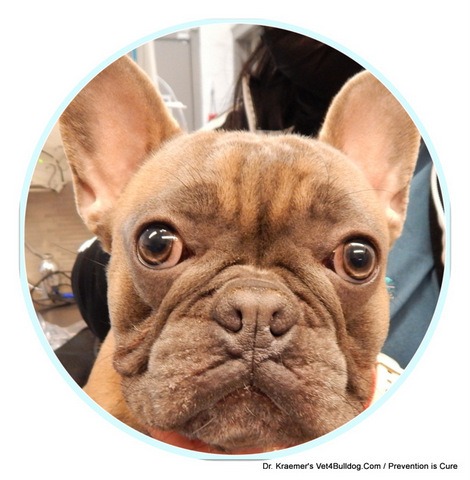
HYPOPLASTIC TRACHEA:
Radiographs are usually sufficient.
ELONGATED SOFT PALATE:
Elongated Soft Palate AUDITORY:
The initial diagnosis is auditory and can be done with videos or tape taken by the bulldog owner during activity or excitement.
Elongated Soft Palate EXAM
and by the medical team during the exam.
Elongated Soft Palate VISUAL INSPECTION:
The definitive diagnosis is a visual inspection that must be done under mild sedation and proper lighting.
EVERTED LARYNGEAL SACCULES:
The definitive diagnosis is a visual inspection combined with a respiratory-stimulating drug. and must be done under mild sedation and proper illumination.
Brachycephalic Airway Syndrome in Bulldogs and French Bulldogs PROGNOSIS:
The overall prognosis for the brachycephalic breeds depends on how many anatomic abnormalities are present at the time of diagnosis and how soon they were corrected.
BULLDOG STENOTIC NARES:
Bulldog Stenotic Nares means narrowed or pinched nostrils; the narrowing restricts the amount of air that can flow into the nostrils. Bulldog and French bulldog Stenotic Nares can be surgically corrected by removing a wedge of tissue from the nostrils….READ MORE
BULLDOG ELONGATED SOFT PALATE:
Sadly, the natural anatomical boundaries of the soft palate were altered as a direct aftermath of selective inbreeding.
The elongated obstructing space is critical for respiration and thus should be surgically trimmed as early as possible….READ MORE
BULLDOG HYPOPLASTIC TRACHEA:
Bulldogs with this condition have an abnormally narrow windpipe that restricts airflow and proper breathing. As with the other upper airway abnormalities, narrowing of your bulldog airways can cause increased airway resistance, as well as an increase in negative intra-airway pressure.
In contrast to the common notion, in the absence of concurrent respiratory or heart disease, trachea hypoplasia is usually tolerated well in bulldogs as long as their elongated palate and stenotic nares are timely repaired.
BULLDOG EVERTED LARYNGEAL SACCULES:
Everted prolapsed laryngeal saccules are small sacs or pouches that are located just inside the larynx; these saccules turn outwards due to the abnormal negative pressure accompanying the increased respiratory effort associated with the Brachycephalic syndrome, These bulging prolapsed saccules will further obstruct airway flow and thus should be surgically removed.
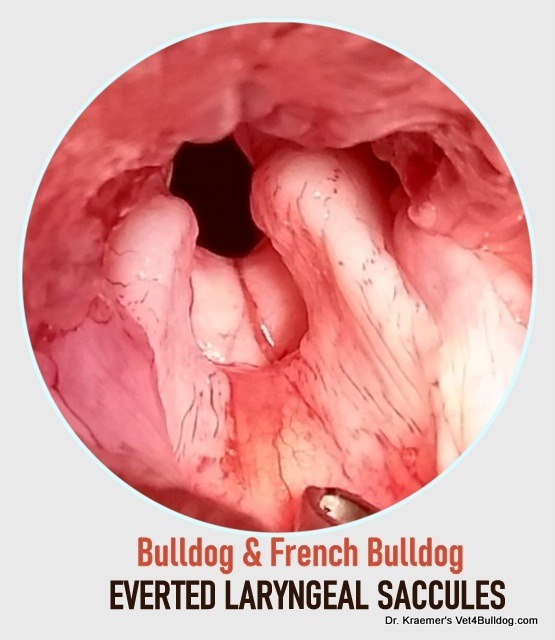
Dr. Kraemer’s Brachycephalic Airway Syndrome in Bulldogs PREVENT & TREAT:
Brachycephalic Airway / WEIGHT CONTROL:
Weight management is critical for bulldogs suffering from BCS.
Brachycephalic Airway / EXERCISE RESTRICTION:
Controlled exercise and minimal excitement
Brachycephalic Airway / CALM & RELAXED:
A calm environment is critical. To help reduce the stress, you should provide a supplement like Dr. Kraemer’s V4B Bully Calm & StressLess Chews.
Brachycephalic Syndrom / CLIMATE CONTROL:
Avoid heat and humid conditions.
Brachycephalic Restrictive Airways / SURGERY CORRECTION:
It’s important to note, that medical management of those conditions does not correct the underlying anatomical abnormalities, but merely lessens the symptoms. Only surgery provides a permanent, long-term solution.
Surgery is the treatment of choice whenever the anatomic abnormalities interfere with normal respiration
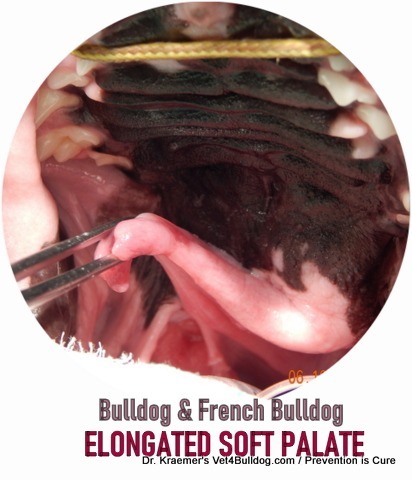
Brachycephalic Airway Syndrome in Bulldogs RULE OF THUMB:
The more abnormalities present the more severe are the symptoms.
The sooner those abnormalities are corrected (surgery), the better the prognosis.
Brachycephalic Airway Syndrome in Bulldogs TIPS & WARNINGS:
DR. KRAEMER’S SOFT PALATE TIPS:
Brachycephalic Restrictive Airway Syndrom / SURGERY:
I recommend surgical repair of the elongated palate and/or stenotic nares as soon as your bully reached maturity at about 8 months of age.
Brachycephalic Restrictive Airway Syndrom / HEAT STROCK:
In the event of a respiratory crisis, you should check rectal temp, normal is between 100-102.5 F. If it is over
105 F and you can’t get to a veterinary hospital, rinse your dog with cool water and place a fan over him/her till the temp drops to 103, don’t let it go below 100F.
Bulldog and Fr. Bulldog BOAS / POSITIONING, & TONGUE:
The thick large bully tongue often retracts inward to further compound the respiratory crisis. If your bully is in respiratory distress or collapse, make sure he/she is sternal (i.e. laying on the sternum/chin, rather than on the side). Pull your bully tongue so it is stretched out, and keep watching the color of the tongue, pink is good, purple-blue is bad
Bulldog and French Bulldog ASPIRATION PNEUMONIA:
Bulldogs suffering from BOAS often gag and vomit.
To prevent aspiration (i.e., aspiration pneumonia), you should:
SLOW FEEDING: Don’t let your bully eat or drink too fast. To slow them down, use cupcake cups or place objects in their water/food dish.
SOFT FOOD: use a blended diet and mix it with water to form a thick, soupy meal.
SMALL & FREQUENT: Feed smaller portions and more frequent meals
ELEVATED FEEDING: feed your dog on a step to elevate his upper body, the more vertical the better.
ANTI-ACID RX: Lastly, to decrease stomach acidity and gastric reflex, discuss with your vets daily RX like anti-acids (i.e., pepsin-c and Prilosec) and antiemetic (anti-vomit) medication.
Brachycephalic Airway Syndrome / HARNESS:
I recommend a harness rather than a neck collar to prevent airflow restriction (all bulldogs)
Bulldog and French bulldog ANESTHESIA:
Read my anesthesia & Sedation chapter and recommendations. I customized special pre-anesthesia bulldog protocols that include anti-vomiting, anti-stress/anxiety medication, anti-inflammatories, and pain relief. My protocol is specially designed to minimize breed-related anesthesia risks and maximize recovery safety
To improve lung condition, we always initiate pre-anesthesia oxygenation by 100% oxygen flow or masking.
Bulldog and Fr. Bulldog Anesthesia / PRE-OP TESTS:
Bulldogs with BOAS have an increased risk of complications associated with general anesthesia, so I recommend:
- LAB WORK: routine pre-anesthetic blood work.
- RADIOGRAPHS: Chest X-rays could be taken to evaluate the
- Esophagus (megaesophagus)
- Trachea (Hypoplastic)
- Lungs (aspiration pneumonia)
- Heart (heart disease)
- Diaphragm (hiatal hernia).
- ECG: Electrocardiograph screening

DR. KRAEMER’S ELONGATED PALATE WARNINGS:
Bulldog palate HEAT & HYPERTHERMIA WARNING:
Symptoms are often worse in hot or humid weather.
Brachycephalic Airway Syndrom / LARYNGEAL EDEMA:
In the early postoperative period, swelling of the surgical sites (laryngeal edema) may occur and interfere with breathing. Thus, we closely monitor our bulldogs after extubation.
In my opinion, the post-extubation period is the most CRTICAL part of “bulldog anesthesia”.
At my practice, we assign a trained technician to sit next to our patients and monitor their vitals till they are extubated and breathing by themself for a while
Bulldog and French Bulldog BREEDING WARNING:
I don’t recommend breeding a bulldog who has required surgery to correct airway obstruction.
Brachycephalic Obstructive Airway Syndrom / LARYNGEAL COLLOPASE:
Over time, bulldogs and French bulldogs with this syndrome will develop other secondary problems that further obstruct airflow. They include very large obstructive tonsils and end-stage collapsed, atrophied larynx cartilages.
Bulldog and French Bulldog HEART DISEASE:
In the long term, the increased effort associated with breathing can put an increased strain on the heart, with heart disease and failure as possible complications.
Bulldog and French Bulldog VOMITING:
Vomiting and gagging are common in brachycephalic breeds (bulldogs) due to an increase in vagal tone, which is a direct outcome of the breed’s excessive upper airway pressure. This increase in vasovagal tone will further intensify in bulldogs with brachycephalic syndrome (such as stenotic nares and an elongated soft palate).
Gagging and vomiting could lead to inhalation of the vomit content, with aspiration pneumonia being the most likely outcome.
Aspiration Pneumonia could have dire consequences and be deadly, particularly for someone going under anesthesia.
Recommended by Owners Approved by Bulldogs



